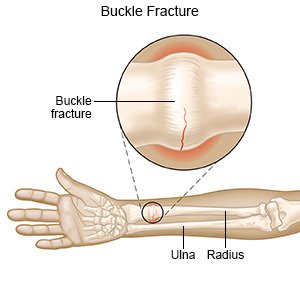Buckle Fracture
Medically reviewed by Drugs.com. Last updated on Aug 4, 2025.
A buckle fracture is a break that does not go completely through the bone. One side of the bone buckles (bulges) when pressure is applied to the other side of the bone. Torus fractures usually occur in the forearm. A buckle fracture is also called a torus fracture.
 |
DISCHARGE INSTRUCTIONS:
Return to the emergency department if:
- Your child's pain gets worse, even after he or she rests and takes medicine.
- Your child's hand or fingers feel numb.
- Your child's skin over the fracture is swollen, cold, or pale.
- Your child cannot move his or her hand or fingers.
Call your child's doctor if:
- Your child's brace or splint becomes wet, damaged, or comes off.
- You have questions or concerns about your child's condition or care.
Medicines:
Your child may need any of the following:
- NSAIDs , such as ibuprofen, help decrease swelling, pain, and fever. This medicine is available with or without a doctor's order. NSAIDs can cause stomach bleeding or kidney problems in certain people. If your child takes blood thinner medicine, always ask if NSAIDs are safe for him or her. Always read the medicine label and follow directions. Do not give these medicines to children younger than 6 months without direction from a healthcare provider.
- Acetaminophen decreases pain and fever. It is available without a doctor's order. Ask how much to give your child and how often to give it. Follow directions. Read the labels of all other medicines your child uses to see if they also contain acetaminophen, or ask your child's doctor or pharmacist. Acetaminophen can cause liver damage if not taken correctly.
- Do not give aspirin to children younger than 18 years. Your child could develop Reye syndrome if he or she has the flu or a fever and takes aspirin. Reye syndrome can cause life-threatening brain and liver damage. Check your child's medicine labels for aspirin or salicylates.
- Give your child's medicine as directed. Contact your child's healthcare provider if you think the medicine is not working as expected. Tell the provider if your child is allergic to any medicine. Keep a current list of the medicines, vitamins, and herbs your child takes. Include the amounts, and when, how, and why they are taken. Bring the list or the medicines in their containers to follow-up visits. Carry your child's medicine list with you in case of an emergency.
Manage your child's symptoms:
- Have your child rest as much as possible. Do not let your child put pressure on the injured area or move it. Ask your child's healthcare provider when he or she can return to sports and other activities.
- Apply ice on your child's injury for 15 to 20 minutes every hour or as directed. Use an ice pack, or put crushed ice in a plastic bag. Cover it with a towel before you place it on your child's skin. Ice helps decrease swelling and pain.
- Elevate the area above the level of your child's heart as often as you can. This will help decrease swelling and pain. Prop the area on pillows or blankets to keep it elevated comfortably.

Care for your child's cast or splint:
Follow instructions about when your child may take a bath or shower. It is important not to get the cast or splint wet. Cover the device with 2 plastic bags before you let your child bathe. Tape the bags to your child's skin to help keep water out. Have your child keep the injured area out of the water in case the bag breaks.
- Check the skin around your child's cast or splint each day for any redness or open skin.
- Do not let your child use a sharp or pointed object to scratch the skin under the brace or splint.
- Do not let your child push down or lean on any part of the cast, because it may break.
Follow up with your child's doctor as directed:
Write down your questions so you remember to ask them during your visits.
© Copyright Merative 2025 Information is for End User's use only and may not be sold, redistributed or otherwise used for commercial purposes.
The above information is an educational aid only. It is not intended as medical advice for individual conditions or treatments. Talk to your doctor, nurse or pharmacist before following any medical regimen to see if it is safe and effective for you.
Learn more about Buckle Fracture
Care guides
Further information
Always consult your healthcare provider to ensure the information displayed on this page applies to your personal circumstances.
